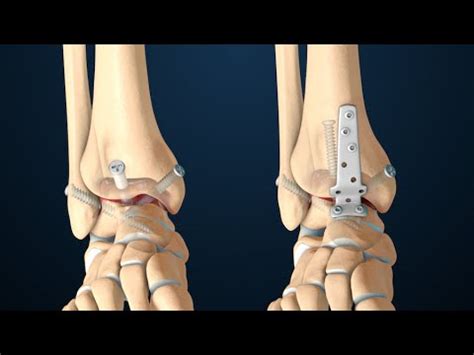Ankle fusion surgery, also known as ankle arthrodesis, is a surgical procedure designed to relieve pain and stabilize the ankle joint by fusion of the bones that make up the joint. This surgery is typically considered for patients who have severe, end-stage ankle arthritis, significant deformity, or failed previous ankle replacement surgeries. The primary goal of ankle fusion is to eliminate pain by removing the joint, thereby preventing further degeneration and allowing for a return to functional activities.
Understanding Ankle Arthritis
Before diving into the specifics of ankle fusion surgery, it’s essential to understand the condition it aims to alleviate: ankle arthritis. Ankle arthritis is a degenerative condition characterized by the breakdown of cartilage in the ankle joint. Cartilage serves as a cushion between the bones, allowing for smooth movement. When this cartilage deteriorates, the bones can rub against each other, leading to pain, stiffness, and swelling. Arthritis in the ankle can result from various factors, including trauma, inherited conditions, infections, or simply wear and tear over time.
The Procedure
Ankle fusion surgery involves several steps. The procedure typically begins with anesthesia to ensure the patient’s comfort during the operation. The surgeon then makes an incision in the ankle to access the joint. The next step involves removing the damaged cartilage and preparing the bone ends for fusion. This might include cutting and reshaping the bones to ensure they fit together properly. The surgeon then uses plates, screws, or rods to hold the bones in place while they heal and fuse together. In some cases, bone grafts may be used to help stimulate the healing process.
Recovery and Rehabilitation
The recovery process for ankle fusion surgery is extensive and requires patience. Immediately following the surgery, the ankle is immobilized in a cast or splint to protect the fusion site. This immobilization period can last several weeks. During this time, it’s crucial to follow the surgeon’s instructions carefully, including any recommendations for pain management, wound care, and follow-up appointments. Once the initial healing has progressed, physical therapy becomes a vital component of the rehabilitation process. A physical therapist will work with the patient to regain strength, improve range of motion in the surrounding joints, and learn how to walk and perform daily activities without putting excessive strain on the fused ankle.
Potential Complications and Considerations
As with any surgical procedure, ankle fusion surgery comes with potential risks and complications. These can include infection, nerve damage, and issues with the bone not healing properly (nonunion). Additionally, because the surgery involves the fusion of bones, it eliminates movement in the ankle joint, which can affect balance and gait. Patients may need to make long-term adjustments to their lifestyle and activities to accommodate the fused joint. Furthermore, the stress from the altered gait mechanics can sometimes lead to arthritis in adjacent joints over time.
Alternatives and Advances
For some patients, alternatives to ankle fusion surgery may be considered, especially if the condition is caught early. These alternatives can include ankle replacement surgery, where an artificial joint is implanted, or less invasive procedures aimed at preserving the natural joint as much as possible. Advances in medical technology and surgical techniques are continually evolving, offering new options for patients with ankle arthritis. For example, cartilage repair, joint distraction procedures, and biologic treatments represent areas of ongoing research and development.
Making the Decision
The decision to undergo ankle fusion surgery should be made after careful consideration and consultation with an orthopedic surgeon. The surgeon will evaluate the extent of the arthritis, the patient’s overall health, and their lifestyle and expectations to determine if ankle fusion is the most appropriate treatment option. It’s also important for patients to understand the implications of the surgery, including the permanent loss of ankle motion, and to discuss any concerns or questions they may have.
What are the primary reasons for undergoing ankle fusion surgery?
+The primary reasons include severe ankle arthritis, significant deformity, or failed previous ankle replacement surgeries, with the goal of relieving pain and stabilizing the ankle joint.
How long does it typically take to recover from ankle fusion surgery?
+Recovery can vary, but it generally involves several weeks of immobilization followed by several months of physical therapy and rehabilitation, with full recovery potentially taking up to a year or more.
Are there any long-term limitations after ankle fusion surgery?
+Yes, patients may experience limitations in mobility and may need to adjust their activities to avoid high-impact exercises. Additionally, there can be an increased risk of developing arthritis in adjacent joints due to altered biomechanics.
In conclusion, ankle fusion surgery is a significant procedure designed for patients with severe ankle conditions who have not found relief through other treatments. While it offers the potential for significant pain reduction and improved function for those suffering from end-stage ankle arthritis, it’s crucial for patients to thoroughly understand the procedure, its implications, and the recovery process. Advances in surgical techniques and rehabilitation continue to improve outcomes, making it an option worth considering for those who qualify.



